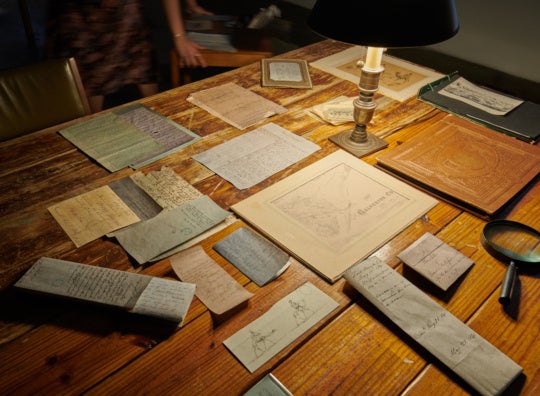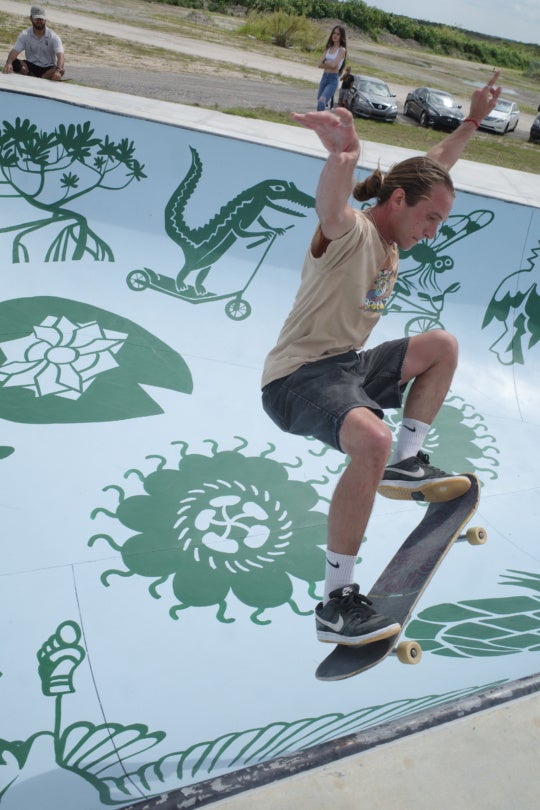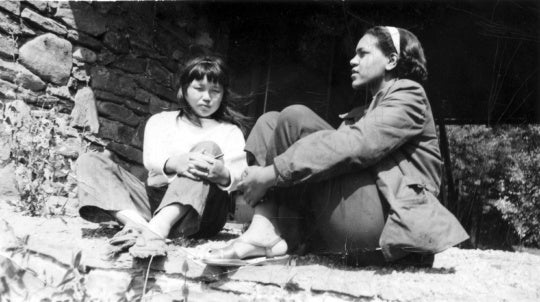
Baptism by Fire by TindelMichi is the latest collaborative effort by John Tindel and Michi Meko. Raised in Alabama and based in Atlanta, the duo pull from their divergent experiences as men of different races, spinning their memories, emotions, and historical knowledge into an imagined mythology. The works serve as collages of the Southern experience, some more successful than others.
The works in Baptism fall into four categories: woodworks, works on paper, assemblage, and works on canvas. Tindel and Meko collaborated on all the pieces except the woodworks, using them to showcase each individual’s style in a series titled Patterns. Tindel displays his “one-time stenciling,” a method in which he layers and incises tape to create single-use stencils. He uses these to create regular patterns that resemble décor effects, though with a rough, textural quality that raises them above wallpaper. For his woodworks, Meko scorched his blocks on an electric stove to create angry round scars like brands on the surface.
Meko’s Patterns resemble Rashid Johnson’s The Sweet Science, 2011, an accumulation of scorch marks, black soap, wax, and paint on red oak flooring. The allusion to slavery and flesh as property are clear in both works.


The references to black history continue in the assemblages by TindelMichi, the most impressive of which is M. Dixon, 2011. This wall-mounted sculpture, composed of shutters and a variety of wooden boards, features a decorative floral design as well as the spectral portrait of a black soldier looming over white birds in a cotton ball nest. The weathered and stained boards impart historical resonance, while the dramatic linearity of the piece heightens the disturbance of elements like a length of chains that drags on the floor.
Less successful are the works on paper, which feature blue-washed scenes by Meko with kaleidoscopic designs by Tindel. The works represent translated memories, stories from the past that Meko transcribes with his brush. In these images, however, the different elements by each artist do not achieve coalition, seeming more like conflicting tags by rival street artists rather than the result of collaboration.
The works on canvas dominate the show, offering the most impactful examples of the artists’ collaborative efforts but also indicating their weaknesses. These range from the bucolic and illustrative to more graphic and definitive. In Hell or High Water, 2010, a faceless nanny watches over a blonde shepherd, who in turn watches one small white sheep. Brown figures stand in the background in varying uniforms, all as faceless as the nanny. Cupid silhouettes with tattered wings caper in the boughs of a tree—this may be a reference to Kara Walker, but the silhouettes lack the sinister comportment of Walker’s works. Symbolic elements abound: peppermint candies appear to be falling from the tree, cotton grows in the distance, and certainly the shepherd has links to Christian theology. The amalgamation of these disparate symbols, however, creates a muddled message; none is distinct enough to have sufficient power.

On the other hand, the works on canvas with more prominent graphic elements resolve the overwrought issues in the more cluttered pictures. In Southern Star, 2012, a large snowflake-like graphic–likely a Tindel creation–dominates the image, layered with crossed stripes (similar to a Confederate flag) speckled with stars. A brown-skinned woman gazes towards the graphic with a wearied expression, while other components like a Greek-style temple, sunflower, and words fade into the background. The simplified composition of Southern Star provides a hierarchy of elements lacking in some of the other works on canvas, resulting in an image that reads almost like signage.
As signs, these works are given greater ability to reference the dark history of authoritarian doctrines in America that diminished the position of people of color. Visually, the images begin to act like political and religious billboards seen on a highway, imparting the message of a particular group yet acting as a site of layered meaning. A viewer is able to read other things about that group, such as economic position, political motivation, and–depending on the style of message–the voice this group believes will sway minds. At their most effective, the works of TindelMichi tap into this type of signifier, revealing the potential of signs as sites of meaning.
The exhibition continues at Barbara Archer Gallery through January 5, 2012.




